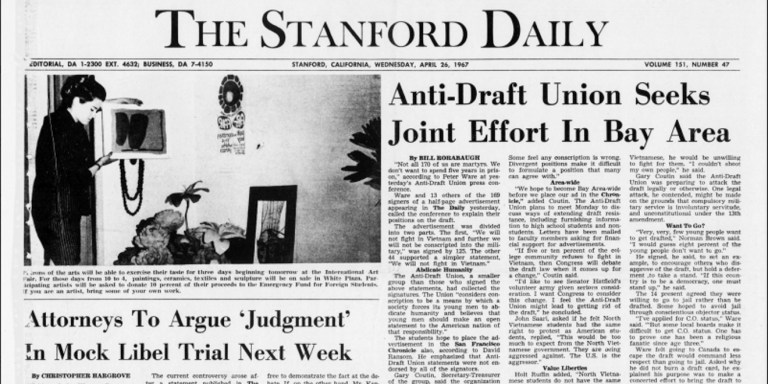The feature “On this day in Stanford history” details events that occurred on the same date in past years at Stanford.
According to The Stanford Daily’s archives, on April 26 in…
1905: A notice was posted calling attention to a rule forbidding shooting on University grounds and anywhere on the Palo Alto estate. The rule was brought up “as a result of the many instances of the use of fire arms which have been reported to the president’s office.” The post added, “It is feared that such shooting may result in serious injuries to persons on the grounds from glancing bullets or stray shots.”
1915: It was announced that a mass meeting of all the women of the university would be held the next day. The Daily reported, “The purpose of the gathering is twofold; first, to make certain amendments to the constitution of the Women’s Conference which have long been necessary; and, secondly, to form a women’s peace movement.”
1918: University president Ray Lyman Wilbur released a statement expressing his pride in Stanford students’ contributions to the World War I effort. He wrote, “We must back up the Western Front today and prepare to break through it in the days to come. It will require the fullest effort of every American, and above all, it will require trained minds by the thousands. Here lies our opportunity and our privilege.”
1928: A robber stole $300 from the Board of Athletic Control offices, most likely as part of “an inside job,” The Daily reported.
1940: President Roosevelt invoked United States neutrality law and extended “cash and carry,” allowing the sale of military supplies to Norway after proclaiming that Norway and Germany were officially at war.
1956: The Daily reported on Southern resistance to the desegregation of buses following a Supreme Court mandate.
1962: A black Labrador retriever, Wazu, campaigned for the post of student body president at the University of California. Campaign manager Mike Scholar said, “We feel student government at Cal is a farce. Students have little to say in the face of the administration’s powers. Perhaps if Wazu wins, they will realize how farcical their government is.”
1972: Two university vehicles were set on fire by arsonists on the south side of Encina Hall. One car was completely destroyed and the other’s floorboards were scorched. The fires were reported by a Wells Fargo Security Guard.
1985: Attorney General Ramsey Clark gave a speech to 70 attendees at Stanford Law School, proclaiming that the “hottest places in hell” are reserved for “those who in times of moral crisis do nothing.”
1990: The campus was made to ration its water due to a shortage of runoff, leading to dry fountains and brown lawns.
2001: The organizers of the new Stanford Student Video program in the Stanford Store told The Daily that they were pleased with the success of the program, which allowed students to rent nearly 300 VHS tapes and over 100 DVDs.
2013: Critics of Stanford’s living wage policy argued that the University should monitor contractors more closely to ensure their compliance with the rules, which aim to ensure that Stanford employees providing services such as maintenance, housing, food service and groundskeeping earn enough money to cover their basic needs. “Under Stanford’s current policy, the living wage does not vary based on a worker’s family situation and thus may be insufficient in some cases,” The Daily reported.
Contact Felicia Hou at fhou ‘at’ stanford.edu.
